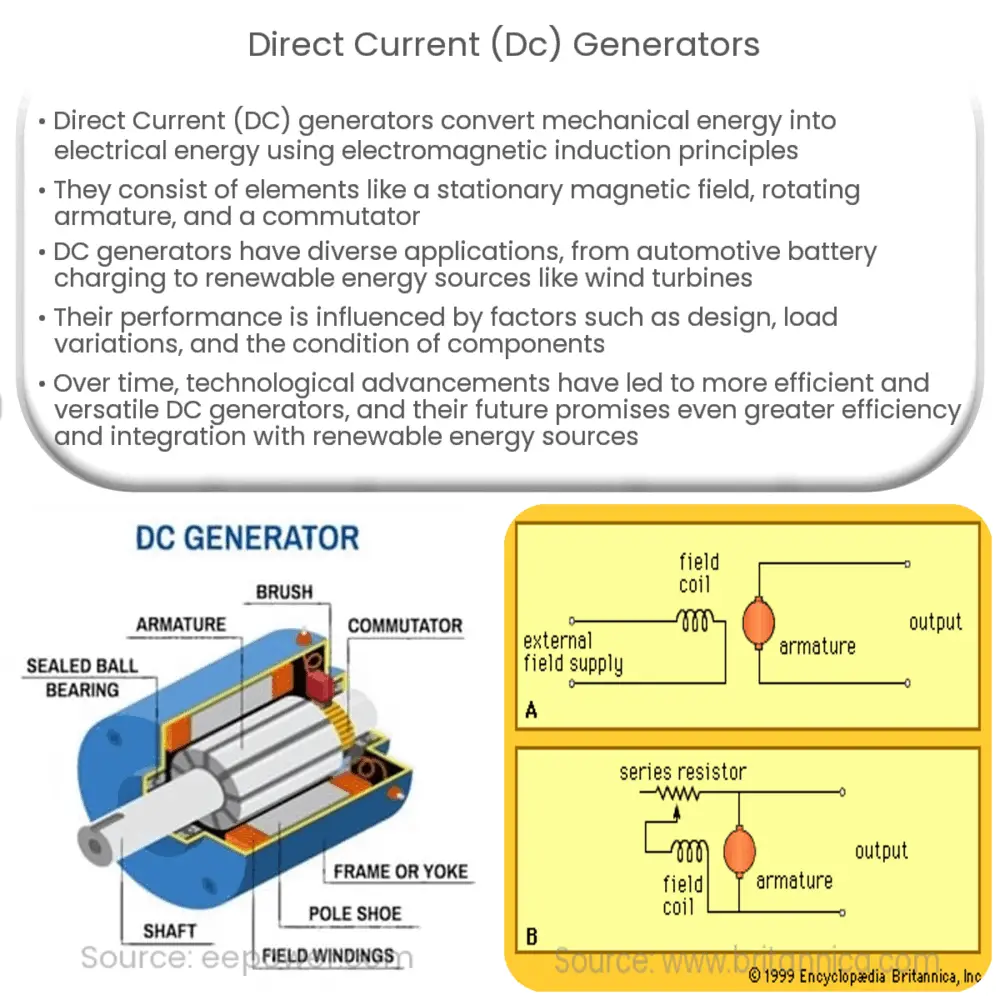Explore the intricacies of Direct Current (DC) generators, their types, applications, performance factors, and future potential in this comprehensive guide.

Understanding Direct Current (DC) Generators
Electricity is a fundamental component of our everyday lives, and the devices that generate it, particularly Direct Current (DC) Generators, are incredibly crucial in this regard. Understanding their functionality provides a valuable insight into the underpinnings of the electrical world around us.
The Basics of DC Generators
Direct Current or DC generators are devices that convert mechanical energy into direct current electrical energy. This is achieved through the principles of electromagnetic induction, a concept first discovered by scientist Michael Faraday in the early 19th century. He demonstrated that a change in the magnetic field within a closed loop of wire induces an electromotive force (EMF), leading to the flow of electric current.
At their core, DC generators consist of a stationary magnetic field, a rotating armature, slip rings, brushes, and a commutator. The mechanical energy, which is often supplied by a prime mover such as an internal combustion engine or a turbine, drives the rotation of the armature. As the armature rotates within the magnetic field, it cuts through magnetic lines of force, generating an EMF.
Types of DC Generators
- Separately Excited DC Generators: These generators have their field magnet windings powered by an independent external DC source.
- Self Excited DC Generators: In these, the field magnet windings are energized by the generator’s own current. Self excited DC generators can be further classified into three types:
- Shunt Generators
- Series Generators
- Compound Generators
Applications of DC Generators
Direct Current (DC) generators have a myriad of uses across various industries. In the automotive industry, they are used in cars for battery charging systems. They are also used in power plants for excitation systems for alternators. In addition, they are employed in electroplating and electrolysis processes. The use of DC generators in renewable energy sources, such as wind turbines, has further increased their significance in recent times.
Performance of DC Generators
The performance of a DC generator is determined by its efficiency and voltage regulation. Efficiency is the ratio of the output power to the input power, typically expressed as a percentage. On the other hand, voltage regulation refers to the change in the terminal voltage when the generator moves from no-load to full-load condition.
Factors Affecting the Performance of DC Generators
Several factors can impact the performance of a DC generator. The efficiency of a generator is influenced by its design, with factors such as friction, resistance in the windings, and losses in the magnetic circuit playing a significant role. In terms of voltage regulation, load variations can result in changes to the terminal voltage, which in turn can affect the generator’s performance.
The condition of the commutator and brushes can also impact the performance. If they are worn or damaged, the flow of current can be hindered, resulting in reduced output. Therefore, regular maintenance and checks are essential for maintaining the efficiency and effectiveness of a DC generator.
The Evolution of DC Generators
Since their inception, DC generators have evolved considerably, primarily due to advancements in technology and materials. Modern designs have resulted in more compact, efficient, and reliable generators. This is facilitated by improvements in magnetic materials, insulation materials, and construction techniques. Today’s DC generators are also designed to work in harsh environments, further extending their utility and versatility.
The Future of DC Generators
As technology continues to advance, the capabilities of DC generators are expected to expand. This includes increased efficiency, more compact designs, and the use of renewable energy sources. For example, advancements in materials science could lead to even more efficient and effective generators. Moreover, as renewable energy continues to gain prominence, we could see more DC generators designed specifically to work with renewable energy sources such as wind, solar, and hydro power.
Conclusion
In conclusion, Direct Current (DC) generators play a vital role in the generation of electricity, converting mechanical energy into electrical energy. From their basic design and operation to the various factors affecting their performance, understanding DC generators provides a comprehensive insight into this pivotal technology. Their widespread applications, continual evolution, and potential future developments highlight their ongoing relevance in our world. As we continue to rely heavily on electrical energy, DC generators, with their versatility and potential for enhancement, remain indispensable components in our lives.

